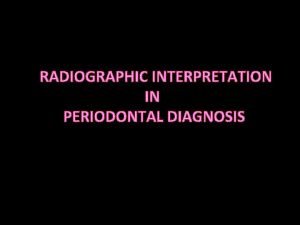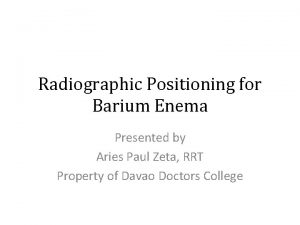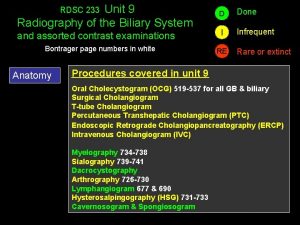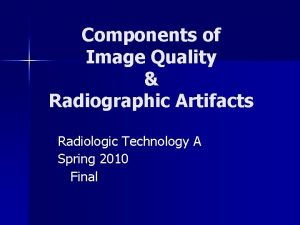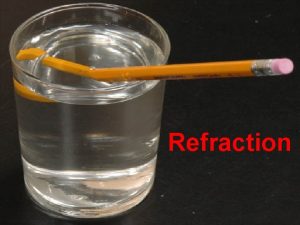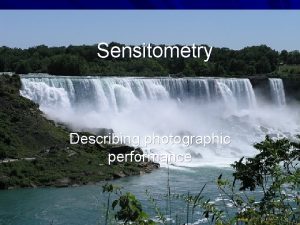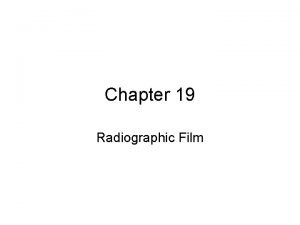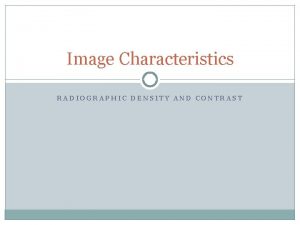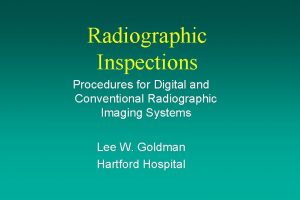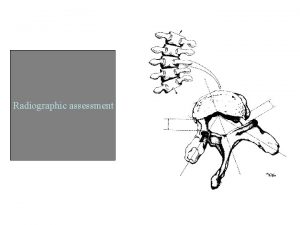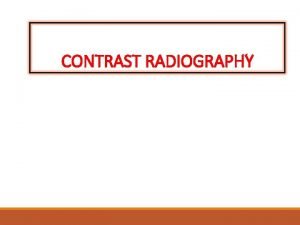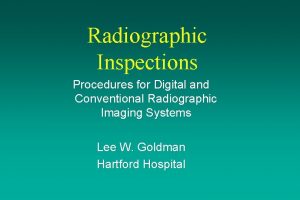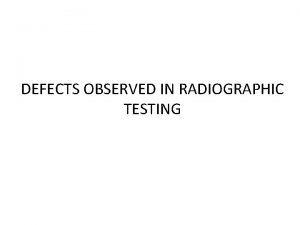Film Optical Density Film screen Radiographic Density Overall

















- Slides: 17

Film Optical Density

Film screen • • Radiographic Density Overall blackening of the radiographic image as a result of the energy deposited inthe film emulsion.

Film screen Radiographic Contrast / Grayscale • The difference between two adjacent • radiographic densities in the image. • • The overall number of density shades present in the image.

Densitometer

Density • . 25 TO -2. 5 • The straight line of the H&D curve

To see changes in optical density • In order to see changes in optical density on a radiograph you must increase you m. As by at least 20 – 30% • To double the density on a radiograph you must double your density

Optical Density • A numerical value indicating the degree of blackening on the film. (average OD seen on a radiograph = 1. 2 Range is 0. 21 – 2. 5) # of photons coming through film = # of photons hitting film OD= 1 =0 1 1 100 1 = 1 10 OD # 2 3 1 = 2 102 1 = 3 100 1000

• Carltons – CH 21 (pg 307) – increments of optical density • • Density log = incident light intensity • transmitted light intensity • • OD # % of light photons transmitted • 0 100 % • 1 10 % • 2 1 % • 3 0. 1 % • If the quantity of black metallic silver on a radiograph • is such that it allow • 1 % of the light to pass through – what is the OD? • 10% • 100%

• 1. 2. 3. 4. An unexposed and processed film will have a density of about? zero 0. 1 1. 0 2. 5

If the quantity of black on the film allows 1% of light to pass through, that film has a density of 1. 0. 01 2. 0. 1 3. 1. 0 4. 2. 0

If the quantity of black on the film allows 10% of light to pass through, that film has a density of 1. 0. 01 2. 0. 1 3. 1. 0 4. 2. 0

• 1. 2. 3. 4. The relationship between the intensity of light striking a film and the intensity of light transmitted through the film is an expression of which of the following? Radiographic contrast Radiographic density Recorded detail Radiographic filtration


Image-forming x-rays • Two kinds of photons are responsible for the OD and contrast on an image: Photons that pass through without interacting and those that are scattered though Compton. • X-rays that exit the patient are remnant and those that interact with the IR are image-forming.

Optical Density • Controlling factor: m. As • m. As determines the quantity of xrays • What is the formula to determine quantity of x-rays?

How is OD measured on a monitor

 Oid in radiology
Oid in radiology Periodontal ligament space radiograph
Periodontal ligament space radiograph Radiographic film
Radiographic film Optical density film
Optical density film Screen small screen offscreen
Screen small screen offscreen Radiographic films
Radiographic films Hampton view positioning
Hampton view positioning Acanthion
Acanthion A radiographic examination of the bile ducts
A radiographic examination of the bile ducts Geometric penumbra formula
Geometric penumbra formula Grid errors radiography
Grid errors radiography Kink marks artifact
Kink marks artifact Maze type entrance
Maze type entrance Reverse townes view positioning
Reverse townes view positioning Anthropological baseline
Anthropological baseline Dental radiography techniques ppt
Dental radiography techniques ppt Optical density refraction
Optical density refraction Optical density of gross fog
Optical density of gross fog

